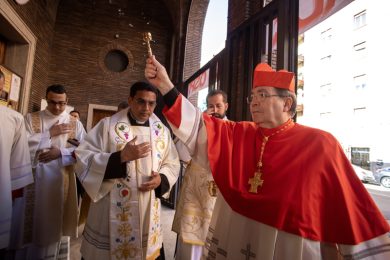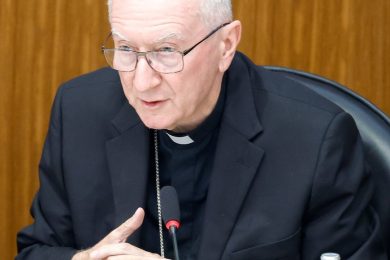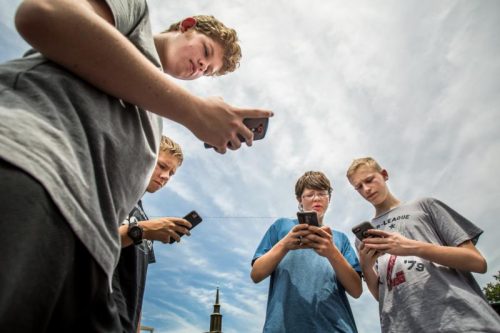Since its release in the United States July 6, Pokemon Go has quickly become a cultural phenomenon.
In the first week, the mobile game attracted nearly 21 million users, according to data from Survey Monkey, making it the most popular app in U.S. history.
As a result, the nature of the game is driving swarms of players to unsuspecting churches, businesses and other landmarks. But as it grows in popularity, priests, youth groups and others are quickly finding opportunities to evangelize to young people.
Pokemon Go uses augmented reality, a real-world environment that incorporates computer-generated elements, such as GPS data, sound and video. Users move around in the real world as they collect tiny virtual creatures called Pokemon — short for pocket monsters. The mobile app is based on the popular franchise that began with several Nintendo games in the 1990s.
Churches, businesses and other landmarks have been designated as PokeStops, where users collect resources needed to catch Pokemon; and Gyms, where competitions are held among the creatures.

St. Francis Xavier Church in Sartell is one of the many churches in the St. Cloud Diocese that have been designated PokeStops or Gyms. Father Tim Baltes, the parish’s pastor, thinks it could be an opportunity to evangelize.
“We always say that God works in mysterious ways,” he said. “Let’s not pass up an opportunity simply because it may be something that I don’t necessarily participate in.”
St. Francis Xavier staff have seen enough people walking around on the grounds staring down at their phones that it prompted a post on the parish Facebook page encouraging players to stay for Mass.
St. Rose of Lima Parish in St. Rosa also posted a welcome for players on its Facebook page.
Assumption Church in south St. Louis County began noticing an influx of visitors to the property July 11.
“On Monday night, we couldn’t figure out why all these people were on our property,” pastor Father Thomas Keller told the St. Louis Review, the archdiocesan newspaper. “We noticed people walking up, or in their car slowing down. By Tuesday, we figured out we had all these Pokemon stops. I talked to a nice couple pushing a baby carriage who explained everything to me.”
The game especially has been attractive to young adults who grew up on Pokemon in the 1990s. Assumption’s associate pastor Father David Miloscia, 29, was into Pokemon from the eighth grade to his sophomore year in high school. He geeked out with a group of five teenagers who visited the parish July 14 on their quest to catch more characters.
Father Miloscia sees this latest trend in mobile gaming is opportunity to connect with others. “I talked with some kids last night when they were on the parking lot,” he said.
“They were happy the church was relating to them in this way,” he told the St. Louis Review, archdiocesan newspaper.” The next thing is that personal interaction. For me, I just rely on the Holy Spirit to make an opening or say the right words.”

What should the church’s response be to Pokemon Go?
According to Julianne Stanz, director of the Department of New Evangelization, in the Diocese of Green Bay, Wisconsin, it should be go — as in “go and make disciples of all nations.”
Stanz and members of her department created a Pokemon Go resource guide for parishes, “A Parish Primer: Responding to Parish Questions and Concerns.”
The four-page guide gives a description of Pokemon Go, a definition of key words, the history of Pokemon and an explanation why parishes should care about the game. The guide is available at www.gbdioc.org/images/Pokevangelization.pdf.
In an email to The Compass, Green Bay’s diocesan newspaper, Stanz said the parish guide was created “in conjunction with a team of parish leaders skilled in evangelization outreach who are looking at using the technology as part of their ministry.”
Stanz said making parishes aware of why people are visiting their church location is the first step in understanding and responding to the Pokemon Go phenomenon.
Visitor staff writer Dianne Towalski contributed to this story.






















